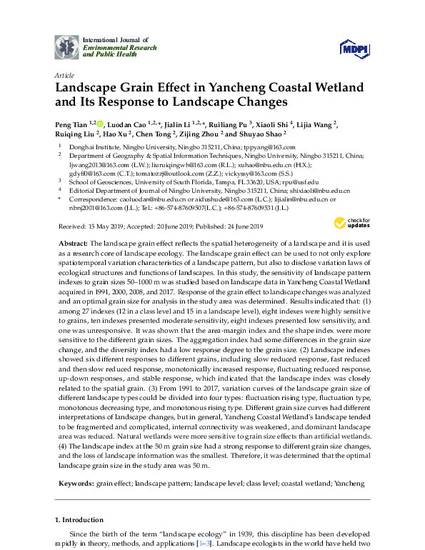
- grain effect,
- landscape pattern,
- landscape level,
- class level,
- coastal wetland,
- Yancheng
The landscape grain effect reflects the spatial heterogeneity of a landscape and it is used as a research core of landscape ecology. The landscape grain effect can be used to not only explore spatiotemporal variation characteristics of a landscape pattern, but also to disclose variation laws of ecological structures and functions of landscapes. In this study, the sensitivity of landscape pattern indexes to grain sizes 50–1000 m was studied based on landscape data in Yancheng Coastal Wetland acquired in 1991, 2000, 2008, and 2017. Response of the grain effect to landscape changes was analyzed and an optimal grain size for analysis in the study area was determined. Results indicated that: (1) among 27 indexes (12 in a class level and 15 in a landscape level), eight indexes were highly sensitive to grains, ten indexes presented moderate sensitivity, eight indexes presented low sensitivity, and one was unresponsive. It was shown that the area-margin index and the shape index were more sensitive to the different grain sizes. The aggregation index had some differences in the grain size change, and the diversity index had a low response degree to the grain size. (2) Landscape indexes showed six different responses to different grains, including slow reduced response, fast reduced and then slow reduced response, monotonically increased response, fluctuating reduced response, up-down responses, and stable response, which indicated that the landscape index was closely related to the spatial grain. (3) From 1991 to 2017, variation curves of the landscape grain size of different landscape types could be divided into four types: fluctuation rising type, fluctuation type, monotonous decreasing type, and monotonous rising type. Different grain size curves had different interpretations of landscape changes, but in general, Yancheng Coastal Wetland’s landscape tended to be fragmented and complicated, internal connectivity was weakened, and dominant landscape area was reduced. Natural wetlands were more sensitive to grain size effects than artificial wetlands. (4) The landscape index at the 50 m grain size had a strong response to different grain size changes, and the loss of landscape information was the smallest. Therefore, it was determined that the optimal landscape grain size in the study area was 50 m.
International Journal of Environmental Research and Public Health, v. 16, issue 12, art. 2225
Available at: http://works.bepress.com/ruiliang-pu/127/